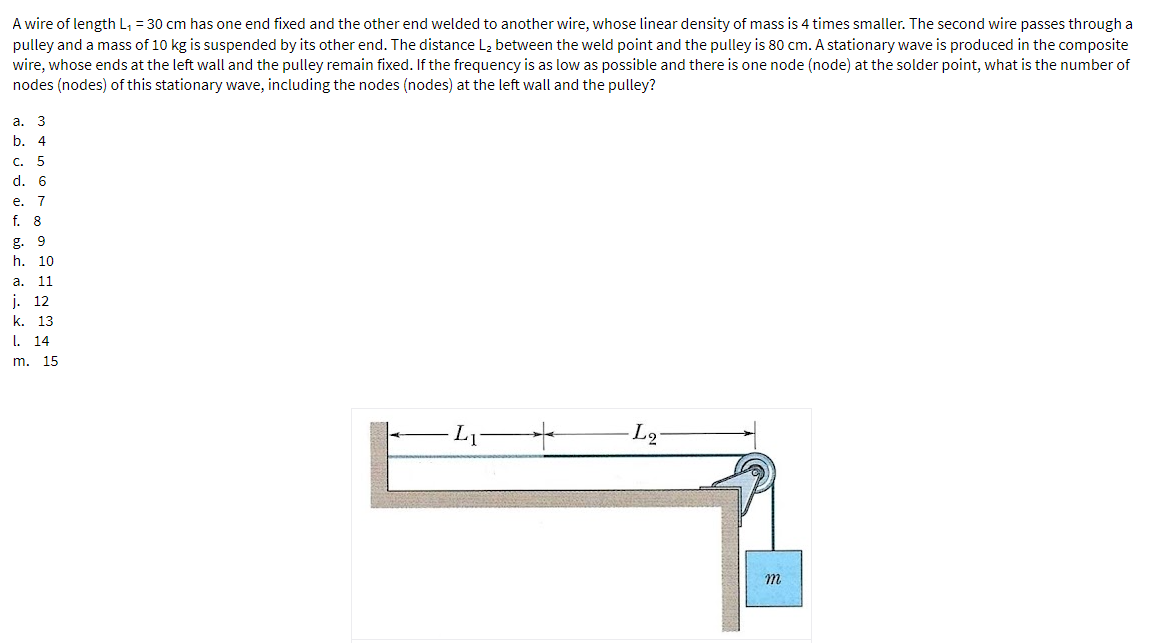A wire of length L, = 30 cm has one end fixed and the other end welded to another wire, whose linear density of mass is 4 times smaller. The second wire passes through a pulley and a mass of 10 kg is suspended by its other end. The distance L2 between the weld point and the pulley is 80 cm. A stationary wave is produced in the composite wire, whose ends at the left wall and the pulley remain fixed. If the frequency is as low as possible and there is one node (node) at the solder point, what is the number of nodes (nodes) of this stationary wave, including the nodes (nodes) at the left wall and the pulley?
A wire of length L, = 30 cm has one end fixed and the other end welded to another wire, whose linear density of mass is 4 times smaller. The second wire passes through a pulley and a mass of 10 kg is suspended by its other end. The distance L2 between the weld point and the pulley is 80 cm. A stationary wave is produced in the composite wire, whose ends at the left wall and the pulley remain fixed. If the frequency is as low as possible and there is one node (node) at the solder point, what is the number of nodes (nodes) of this stationary wave, including the nodes (nodes) at the left wall and the pulley?
Physics for Scientists and Engineers: Foundations and Connections
1st Edition
ISBN:9781133939146
Author:Katz, Debora M.
Publisher:Katz, Debora M.
Chapter17: Traveling Waves
Section: Chapter Questions
Problem 14PQ
Related questions
Question

Transcribed Image Text:A wire of length L, = 30 cm has one end fixed and the other end welded to another wire, whose linear density of mass is 4 times smaller. The second wire passes through a
pulley and a mass of 10 kg is suspended by its other end. The distance L2 between the weld point and the pulley is 80 cm. A stationary wave is produced in the composite
wire, whose ends at the left wall and the pulley remain fixed. If the frequency is as low as possible and there is one node (node) at the solder point, what is the number of
nodes (nodes) of this stationary wave, including the nodes (nodes) at the left wall and the pulley?
а. 3
b.
4
С. 5
d. 6
е. 7
f. 8
g. 9
h. 10
а. 11
j. 12
k. 13
I. 14
m. 15
L1
L2
m
Expert Solution
This question has been solved!
Explore an expertly crafted, step-by-step solution for a thorough understanding of key concepts.
Step by step
Solved in 2 steps with 2 images

Knowledge Booster
Learn more about
Need a deep-dive on the concept behind this application? Look no further. Learn more about this topic, physics and related others by exploring similar questions and additional content below.Recommended textbooks for you

Physics for Scientists and Engineers: Foundations…
Physics
ISBN:
9781133939146
Author:
Katz, Debora M.
Publisher:
Cengage Learning

Principles of Physics: A Calculus-Based Text
Physics
ISBN:
9781133104261
Author:
Raymond A. Serway, John W. Jewett
Publisher:
Cengage Learning

Physics for Scientists and Engineers, Technology …
Physics
ISBN:
9781305116399
Author:
Raymond A. Serway, John W. Jewett
Publisher:
Cengage Learning

Physics for Scientists and Engineers: Foundations…
Physics
ISBN:
9781133939146
Author:
Katz, Debora M.
Publisher:
Cengage Learning

Principles of Physics: A Calculus-Based Text
Physics
ISBN:
9781133104261
Author:
Raymond A. Serway, John W. Jewett
Publisher:
Cengage Learning

Physics for Scientists and Engineers, Technology …
Physics
ISBN:
9781305116399
Author:
Raymond A. Serway, John W. Jewett
Publisher:
Cengage Learning